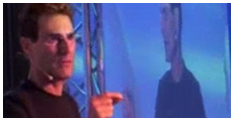Chapter 10
Directional effects
We have seen in previous chapters that the spontaneous nature of dynamic strain signals implies that there is a distribution in their magnitude, their placement and their scale. We would expect that the directions of the strain vectors would also be distributed. But no experimental evidence has so far been presented that the strain gauges in previous experiments recorded vectors directed precisely along their maximum sensitivity axis. Since they were mounted with their axes along narrow metal strips (e.g. 40 cm X 8 mm X 0.75 mm) there is perhaps a psychological reason why the vector should have been directed along the axis of the strip. I have never come across long thin metal strips paranormally curled into straight tubes; bends across the major axis are usual. I regarded it as probable that both bending and stretching signals acted in a direction fairly close to the major axis of a thin and narrow strip.
When I started experimenting with metal strips rather broader and shorter than before (e.g. 15 mm X 20 cm X 0.75 mm), I deliberately mounted a strain gauge across the breadth of the strip, at right angles to its long axis. If all strain vectors were directly along that axis, no signals would be detected in the cross-breadth strain gauge. But small signals from Stephen North and from Mark Henry were observed on it.
I therefore decided to determine just what the distribution of directions of strain signal vectors might be in a metal-bending session. In order that an elongated shape such as a long thin strip might not affect this distribution psychologically, I chose square and circular specimens of thin metal sheet which the metal-bender would not feel inclined to bend in any particular direction, except horizontally or vertically.
The direction of a strain vector might be measured by comparing the magnitudes of the two signals obtained on two strain gauges mutually perpendicular. Ideally they would be mounted one on top of the other, on the surface of the thin specimen. But the strain at a point in a metal specimen is not adequately described by a single vector.
Nevertheless the strain tensor at the surface of a thin specimen is reasonably well defined by a stretching vector in one direction, combined with a contraction vector in a direction at right angles to it. For the determination of three quantities, two magnitudes and an angle, three strain gauges are necessary; two are arranged mutually perpendicular, and the third along the line bisecting the right angle.
Suppose that the first strain gauge is directed along the x axis (Figure 10.1) and that it receives a stretching signal I1; second strain gauge is arranged along the y axis and receives a stretching signal I2; the third sensor is arranged at an angle bisecting that between 1 and 2, and receives a stretching signal I3. We assume that the strain tensor can be approximated by an extension vector Ie at an angle theta to the x axis, combined with a contraction vector Ic at an angle theta + pi/2. Then it can be shown that:
Ie = (alpha + beta)/2
and
Ic = (alpha – beta)/2
where alpha =I1 + I2
and beta = (I1 -I2 )*cos squared theta
Also theta = 1/2 arctan [(2*I3 – I1 – I2 )/(I1 – I2 )]
Thus from three signals I1,I2,I3, which may be of either sign, we can determine Ie and Ic, both of which may also be of either sign. There is no method by which any strain across the thickness of the metal can be determined with this arrangement but if the sign of Ie and Ic are the same, then we can infer the presence of such a strain of opposite sign.
Figure 10.1 Directions of strain gauges 1, 2 and 3 mounted in the ‘rosette’ configuration at 0°, 90° and 45°, one directly over the other. Extension (positive) and contraction (negative) signals at these allow the deduction of the direction of the applied extension signal Ie and orthogonal contraction signal Ic
Several experiments have been carried out with Stephen North to determine the distribution of signal directions. The data were of higher quality than in early strain gauge experiments, due partly to the increasing interest and patience of Stephen, partly to improvements in the amplifier stability and noise level, and partly to the presence of David Robertson, a physics student who assisted in this work and helped to establish a fully relaxed atmosphere.
We can conveniently express the results of an analysis of each experimental session in the form of a ‘star diagram’, such as that shown in Figure 10.2. Each full line of the star represents by its magnitude and direction the stretching vector corresponding to a signal. Contraction vectors are represented by broken lines, and the pairs of orthogonal vectors are numbered so as to show which corresponds to which. In general the stars are of a random appearance. Specimens were mounted vertically.
Figure 10.2 Typical ‘star diagram’ in which each extension signal is represented as a solid line whose length is a measure of its magnitude. It is usually accompanied by the orthogonal contraction signal, represented as a broken line; numbers indicate the correspondence. The square aluminium sheet, with the strain gauges at its centre, is suspended with one corner uppermost.
| Session | Shape of specimen | Remarks | No. of extensions accompanied by contraction | No. of extensions accompanied by extension | No. of contractions accompanied by contraction |
| SN N | Square side 5 cm | 33 | 4 | 0 | |
| SN O | Square side 5 cm | 18 | 5 | 8 | |
| SN U | Square side 5 cm | Two permanent deformations | 37 | 4 | 3 |
| GC 2 | Square side 5 cm | 2 | 5 | 0 | |
| SN Z | Circular 3.7 cm diam. | Low coupling arm mounting | 11 | 4 | 0 |
| SN CC | Circular 3.7 cm diam. | Low coupling arm mounting; 1 sensor fractured | 11 | 6 | 0 |
Some numerical results of analysis of the direction experiments with Gill Costin and Stephen are given in Table 10.1 and with Stephen in Figures 10.3 and 10.4. It will be seen that there are events in which both orthogonal signals are stretches, or both contractions, rather than one of each. This situation represents either an all-round expansion, or an all-round contraction, rather than a single stretching vector with its corresponding contraction at right angles (i.e. pulling or pushing by four hands rather than by two). As we have seen, information about behaviour in the third dimension, i.e. across the thickness of disc, is available only by inference. Diaphragm sensors, made in the form of an Archimedean spiral, are now available for sensing strains perpendicular to the metal surface; they have an obvious application to solving this problem, and in recent experiments dynamic signals have been obtained with their use. Thus a thin disc of metal can experience a dynamic compression or thickening.
Figure 10.3 Histogram of-(Ie/Ic) values for Stephen North’s session U.
Figure 10.4 Histogram of directions of extension signals for Stephen North’s session U. The square metal specimen is mounted with one corner uppermost, and the action is concentrated slightly above horizontal; it is not parallel to the sides of the square.


Latest Articles

Motivational Inspirational Speaker
Motivational, inspirational, empowering compelling 'infotainment' which leaves the audience amazed, mesmerized, motivated, enthusiastic, revitalised and with a much improved positive mental attitude, state of mind & self-belief.



















